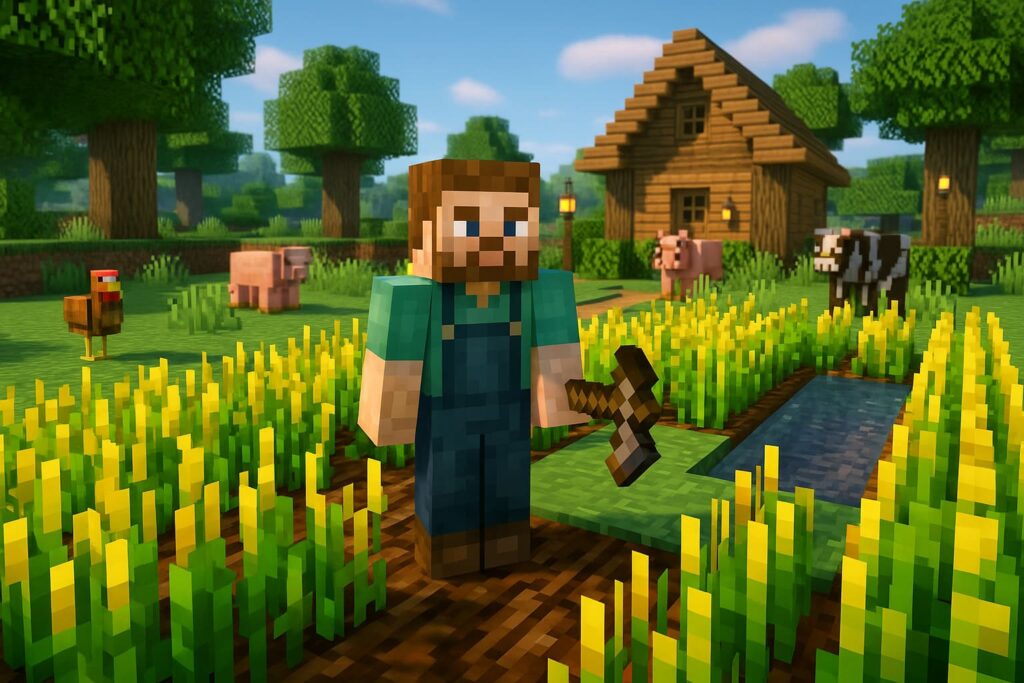I grew up in the city. The kind of city where vegetables came wrapped in plastic, and the only cows I saw were cartoon mascots on milk cartons. I didn’t know how rice was grown, or what wheat even looked like in the ground. Farming? That was a world completely foreign to me—until I started playing Minecraft.

What began as a simple sandbox game quickly transformed into something else: a digital countryside where I became, quite unexpectedly, a real farmer. Not a passive spectator. Not a builder alone. But a player who learned how to prepare soil, plant crops, raise animals, and—most surprisingly—feel a deep appreciation for the quiet rhythm of rural life.
Day One: Hunger Teaches You Fast
My journey began the same as everyone else’s: I spawned in a random world, punched a tree, and crafted a wooden pickaxe. But it wasn’t long before the hunger bar started dropping. Fast.
I’d ignored food. Rookie mistake.
Panicking, I ran around slashing grass until I got wheat seeds. Then I made a wooden hoe, tilled the nearest patch of dirt, and planted the seeds. But nothing happened.
Then came the realization: crops need water.
And light.
And time.
Suddenly, Minecraft stopped being just a game. It became a crash course in survival. I was learning agriculture—not from a textbook, but from necessity.
Lessons in Soil and Sunlight
My first real farm was tiny. Just a 3×3 plot of farmland beside a stream. I learned that tilled soil dries out if it’s not near water. I discovered that trampling over farmland breaks it. I even realized that crops grow slowly without enough light—so I placed torches nearby, creating a soft nighttime glow around my infant wheat field.
It was humble. But it was mine.
That first harvest—just three stalks of wheat—felt like gold. I crafted my first bread with pride. That small meal wasn’t just filling my hunger bar—it was feeding something else. Something like self-reliance.
From Crops to Livestock: Expanding the Homestead
Once I had steady wheat production, I realized I could do more. I lured two cows back to my base using wheat, built a tiny wooden pen, and fed them. Moments later, a baby calf appeared.
I was stunned. I had created life.
Next came chickens, pigs, and sheep. Each species had its own needs—seeds, carrots, or wheat—and I learned to manage them all. I built coops and stables, fences and gates. I bred animals responsibly, culled some for food and materials, and even gave them names.
It sounds silly, but these digital creatures became part of my world. Feeding them every morning became a ritual. Harvesting eggs, shearing sheep, and milking cows—all part of my new daily routine.
I, the city kid who once thought milk came from a bottle, was now running a full-fledged farm.
Seasons of Patience
Farming in Minecraft, much like in real life, teaches you patience.
Crops take time. Animals take time. There’s no shortcut.
You wait.
You nurture.
And eventually, you harvest.
Minecraft doesn’t rush you. There’s no clock ticking down, no penalty for doing things slowly. And in that slowness, I found calm.
I started logging in just to check on the crops, to expand a fence line, to beautify the farm with lanterns or flowerbeds. I was no longer chasing diamonds or exploring mineshafts. I was tending to a quiet corner of the world.
It was enough.
Automation and the Ethics of Efficiency
Eventually, curiosity led me down the path of redstone and automation. I built automatic chicken cookers, semi-automatic wheat farms, and hopper-fed storage systems. I watched tutorials and copied builds.
At first, it felt empowering. Efficient. Modern.
But something strange happened: I missed the manual labor.
Pushing a button to harvest wheat wasn’t nearly as satisfying as doing it by hand. Farming became numbers and outputs, and the peace I once found began to fade.
That’s when I understood: it wasn’t just the result that mattered. It was the process.
Sometimes, slow is better.
So I kept a section of my farm old-fashioned—hand-planted, hand-harvested, torches and all. It reminded me why I started.
Philosophy in Pixels
I never expected Minecraft to teach me anything. But the lessons came anyway:
- That good things take time.
- That labor has value, even when no one sees it.
- That simplicity isn’t lesser—it’s richer.
- That routine can be grounding.
- That caring for something—even if it’s virtual—matters.
In the quiet cluck of chickens, the gentle rustle of wheat, the early morning dew rendered in pixels—I found something oddly sacred.
From Game to Life: Real-World Reflections
Since becoming a Minecraft farmer, I’ve changed in small ways.
I started growing herbs on my apartment balcony.
I learned to cook more intentionally, to appreciate ingredients.
I started waking up earlier, enjoying the stillness of mornings.
I became more patient—with people, with tasks, with myself.
All because of a block game.
Minecraft didn’t just give me a digital farm. It gave me a new way of seeing the world.
Conclusion: Farming Isn’t About Land—It’s About Heart
I may not have acres of real soil. I may never hold a pitchfork or feed hay to a cow. But in Minecraft, I became something I never imagined: a farmer.
And not just any farmer. A patient one. A proud one. A peaceful one.
So next time someone scoffs at Minecraft, calls it childish or simple, I’ll smile.
Because while they were chasing high scores or fast wins, I was waking up with the sun, planting carrots, and listening to the wind blow through a field of pixelated wheat.
And honestly, I wouldn’t trade that for anything.



